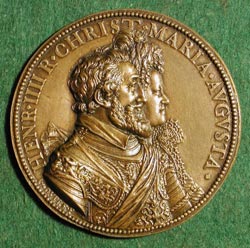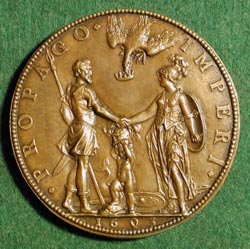

|
HENRI IV, MARIE DE MEDICI AND THE DAUPHIN DUPRÉ, Guillaume: France, 1603, Bronze (cast), 67 mm Henry IV (1553-1610), King of France was the son of Antoine de Bourbon, duke of Vendome, and Jeanne d'Albret, Queen of Navarre. He was the first of the Bourbon dynasty and, as a protestant, was recognized as leader of the Huguenots. On his mother's death in 1572 Henry became king of Navarre and married Margaret de Valois, sister of Charles IX of France and daughter of Catherine de Medici, in the belief that this would end the civil war between the Huguenots and Catholics. However, a few days later the Saint Bartholomew's Day Massacre took place and Henry survived only by appearing to convert to Roman Catholicism. The assassination of Henry III in 1589 left Henry king of France. He converted to Roman Catholicism in 1593 and in 1598 ended the French Wars of Religion by signing the Edict of Nantes, under which Roman Catholicism remained the state church while Huguenots were given some religious freedom. After his marriage to Margaret de Valois was annulled, he married Marie de Medici (1600). They had several children, the first of which was Louis (1601) (the future Louis XIII of France), depicted as a child on the reverse of this medal. Their other children included Elizabeth, who married Philip IV of Spain, and Henrietta, wife of Charles I of England. Although dated 1603, this medal commemorates the birth of the dauphine in 1601. It is said to be the most important in Dupre's career. The reverse is based on coins of Plautilla, wife of the Roman emperor Caracalla (AD 198-217), which have the same legend, and show Caracalla and Plautilla clasping hands (Jones). Others suggest that the portrait of Henry IV and the reverse composition of this medal may have been the source for a painting in Ruben's cycle on the Life of Marie de Medici, now in the Louvre. (Kress). LINK to PAINTING OF HENRY IV AND MARIE DE MEDICI - The Apotheosis of Henry IV and the Proclamation of the Regency of Marie de Medici by Peter Paul Rubens (from Web Gallery of Art) |
|